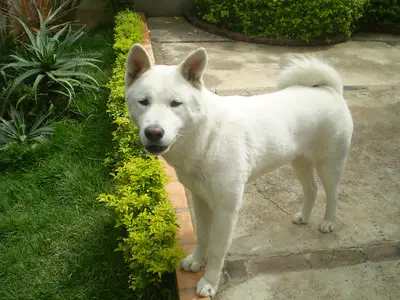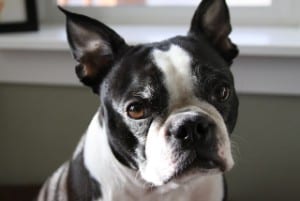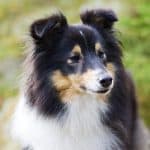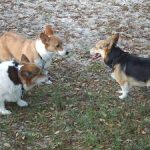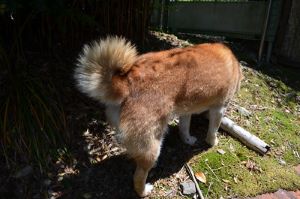
Welcome to my article about dogs with fluffy tails.
Now, for most dog owners, it would be a hard task to single out one feature that makes their dogs so special.
Because we love them so much.
But that isn’t the case for everyone and I think it is a whole different ball game for people who are just starting their search for the dog of their dreams.
I think these people often have one key quality that they are looking for in their next dog.
And so, to help those of you who are in this category, my article today focuses on 11 dog breeds with fluffy tails.
As well as the list being extensive, it is also pretty varied.
This is because the smallest breed on my list is a Pomeranian which can weigh a mere 7 pounds compared to a Tibetan Mastiff which can weigh up to 150 pounds.
As well as everything in between these two extremes.
But before I start looking at specific breeds, I want to talk a little more about fluffy tails.
Why do dogs have fluffy tails?
There are two reasons that dogs are bred to have fluffy tails.
The first and oldest reason is that dogs were bred to have fluffy tails because they worked in very cold places where a fluffy tail would help to keep them warm.
When these dogs lay down to sleep, they would make their bodies as small as possible by curling themselves into a ball and wrapping their fluffy tails around their heads.
And these working breeds of dogs form much of the second half of my list.
The dog breeds that are in the first part of my list tend to be smaller breed dogs.
These dogs don’t have fluffy tails because it helps them keep warm.
These dogs have fluffy tails because it completes “a look” that the dog has.
A fluffy tail makes the dog look cuter or more attractive.
And talking of which, let me start going through my list.
And my first breed, is the Pomeranian.
1. Pomeranian
Are these the smallest dogs with the fluffiest tails? Quite possibly.
But of course with a Pomeranian, the fluff doesn’t just cover their tail but their whole body.
And the tail is quite apt on a dog which in fading light can be mistaken for a baby fox.
So what do these small dogs provide their owners, apart from a fluffy tail?
These dogs are known for their fierce loyalty- sometimes to a family, sometimes even to one person in the family.
If you want a portable watchdog that can take almost anywhere, the Pomeranian alarm system might just be what you are looking for.
These dogs aren’t suitable if you have other dogs in the house or if you have children who are still young enough that they either like to cuddle or shout at a dog!
Although they might look pretty and delicate, looks can be deceiving because even though these dogs might only weigh 7 pounds, they act like they weigh ten times that amount.
And because a fluffy tail can need a bit of TLC with all the dirt and detritus that can get stuck in them, these dogs will lap up all of that close attention.
2. Pekingese
If you didn’t know that Pomeranians were originally bred in Poland, then your geography needs to be very poor to not understand that Pekingese dogs have origins in the Chinese city of Peking!
Or as it is now called Beijing.
The interesting thing about Pekingese is that they do have fluffy tails but sometimes you will be hard pressed to find them because they can be lost amongst the fluffy fur alng the back of a dog.
These are dogs who were bred originally for Chinese royalty many centuries ago and still think that they deserve the royal treatment.
To bolster this impression, Pekingese have a mane rather like a lion- another King in a jungle.
The mane is created by exceptionally long hair around their neck and shoulders.
To complete a fairly unique look, Pekingese combine a flat face and large eyes with a rather peculiar way of walking.
Called a rolling gait, these dogs walk by rolling their hips.
If this makes their movement a bit laboured and slow then it was thought that this trait was nurtured deliberately to stop these dogs from escaping the royal palaces of their owners.
3. Bichon Frise
Keeping with dogs on the shorter side of life, our next specimen is the Bichon Frise.
Since they only come in one colour (pure white), perhaps they can be described as one of the most difficult breeds to keep clean.
It seems that these dogs have both Spanish and French heritage.
And another dog with royal links to both the Spanish and French Royal households.
Links that go back to at least the 13th century.
And with a coat that has such a tight knit curl, there was a poodle somewhere in the creative process.
Their tail falls over the top of their back in a similar way that a spider plant falls out of a plant pot.
Bichons tend to be less territorial or possessive than other dogs and more easy going- particularly with children.
And another rare quality for a small dog is that they like water.
This is because one of their original purposes was that they were bred as companion dogs for sailors.
4. Shih Tzu
My mother in law had a couple of Shih Tzus and she absolutely adored them.
These are another dog breed with their origins in Asia thousands of years ago.
But Shih Tzus were created in Tibet, not China.
And a rough translation of Shi Tzu is Lion Dog.
It is thought that several thousand years ago, these dogs travelled with the Buddha.
Known for their flat noses, large eyes and (in some cases) very long hair, it is sometimes easy to not notice their fluffy tail.
In terms of their tail, it is very similar to the tail on a Bichon in that it is made up of several individual strands of hair which fall over the back of the dog almost like a fountain of water.
It seems to me that a Shih Tzu which has a long and flowing coat is almost like a miniature version of an Afghan hound.
Shi Tzus are great companion dogs but are laid back enough to enjoy playing with children.
Medium
5. Norwegian Elkhound
Staying in Northern Europe, our next dog takes us to Norway- or at least its ancestors did.
Another spitz breed of dog, the Norweigian Elkhound is the national dog of Norway.
Although these dogs can be used for guarding or herding livestock, they are mostly used for hunting moose or elk.
Its coat is very wolf-like with the black, grey and white hairs camouflaging the dog in its surroundings.
These are working dogs that form very close bonds with a few people.
They love being in a pack no matter if the pack is human or canine.
6. Shiba Inu
I didn’t realise that as well as being a famous Japanese dog breed, Shiba Inu is also the name of a crypto currency!
Shiba Inus are hunting dogs originating from Japan.
They are a small to medium sized breed who will need to be well exercised and stimulated in order to make sure that they are happy.
They have a curly and really fluffy tail much like a fox.
And it serves a real purpose.
Because when these dogs sleep, they curl themselves into a ball and their tail covers their head.
Keeping them warm in cold weather.
These dogs were originally bred to hunt in the mountains.
7. Samoyed
From a hunting dog to a herding dog, our next dog is the Samoyed.
And we move from Japan to Siberia in search of another dog with a fluffy tail.
And lo and behold, this dog is another Spitz breed of dog.
The most popular colour of a Samoyed is pure white which makes perfect sense for a working dog in Siberia.
These dogs have done everything from herding reindeers to pulling sleds on expeditions to the North Pole.
A fluffy tail is one of the distinguishing features of this breed although how erect it is held will depend on how alert a dog might be.
8. American Eskimo Dog
Our final spitz breed of dog might leave you a bit confused about why I included it.
After all, the photo won’t help as you will just come to the same conclusion.
That the American Eskimo Dog (AED) and the Samoyed are the same dog.
I mean they must be identical twins.
And you are right.
If I was to spend time describing the AED, I would just be repeating what I have already written about the Samoyed.
Well almost. With one important exception.
When it comes to size Samoyeds are larger.
Strictly speaking, the largest size for an AED (19” high) is the smallest recommended size of a Samoyed.
And so if you liked the look of a Samoyed but were put off by its size and all that that entails (larger food bills, more exercise etc) then the AED might be your perfect dog.
A dog that has a body that is as fluffy as its tail as is pure as driven snow.
9. Chow Chow
From Siberia to Northern China we go in search of our next fluffy tailed dog.
And Northern China is the ancestral home of the Chow Chow.
Not only does this name sound great as it is but the translation of Chow Chow is puffy lion.
Which is very, very apt.
If it is possible to have a cross between a lion and a cuddly bear then here we are.
As the name puffy suggests, this dog is all fluff from its tail to its hairy chest.
A chest that is so hairy that it is like a lion’s mane!
Large
10. Alaskan Malamute
Moving onto our large breeds of dogs now, we start off with the Malamute.
Which many people easily mistake for a Husky.
I mean both of them pull sleds across snow, don’t they?
And they both have gorgeous fluffy tails that can curl up around their nose, like a scarf?
But, the average Malamute is taller and heavier than a Husky.
A male Malamute should weigh around 85 pounds (or 38 kilograms), whereas a male Husky should top the scales at around 60 pounds (27 kilos.)
Malamutes are bigger because they are bred to pull heavy loads over short distances whereas Huskies are bred to pull light loads across longer distances.
Whereas the Husky is native to Siberia, the Malamute is native to Alaska.
There are some key physical differences as well.
A Malamute’s coat is coarser than a Husky and their coat is longer on some parts of their body than others.
A Husky’s coat is the same length all over.
Also the Malamute has a broader muzzle than the Husky.
11. Tibetian Mastiff
From a large and powerful dog, we move onto a giant of the dog world.
And what better way to finish than with the largest dog on our list?
An 85 pound Malamute is a large dog but a Tibetian Mastiff can weigh up to 150 pounds, making it a monster of a dog.
Bred to guard livestock in the mountains of Tibet, a Tibetan mastiff is another breed that needs a fluffy tail to keep it warm.
So it might be quite a surprise to learn that these huge dogs can move at speed for short distances.
Yet as effective as these Mastiffs are at guarding livestock, they can make excellent family dogs, as long as they have enough space, exercise, socialisation and training.
Photo credits
¹ Photo by Yuya Tamai on Flickr

